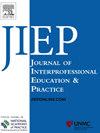Identifying barriers in post-concussion clinical management and interprofessional collaboration among healthcare providers in New Mexico: A descriptive report
Q3 Social Sciences
Journal of Interprofessional Education and Practice
Pub Date : 2025-07-19
DOI:10.1016/j.xjep.2025.100760
引用次数: 0
Abstract
Background
Concussion is a major public health concern affecting millions of youth, adolescent, and young adults annually. Many concussion consensus guidelines recommend use of interprofessional collaborations to support continuity of care. Despite advancements in concussion literature, there are limited studies investigating concussion training and management among interprofessional healthcare providers in consideration of patient- and clinic-specific barriers, all of which may hinder successful post-concussion management.
Objective
To a) compare concussion training, roles and responsibilities of interprofessional healthcare providers in New Mexico (NM) and b) identify barriers to providing post-concussion care.
Methods
An electronic survey was administered to interprofessional healthcare providers across NM from May–November 2023 (N = 73; with n = 42 included in the final analyses).
Results
Participants indicated they used a multi-modal approach to acquire concussion training, with a majority providing care for concussions resulting from motor vehicle accidents, sport, and/or recreational activities. Moreover, the lowest levels of interprofessional collaboration were centered in partnership and coordination. Lastly, qualitative analyses yielded several representative examples of the five of Social Determinants of Health (SDoH).
Conclusion
Our study highlights the unique SDoH of residents in NM which may influence concussion disclosure and/or compliance. Additional research is warranted to evaluate strategies to enhance interprofessional collaborative concussion management in consideration of SDoH.
确定新墨西哥州医疗保健提供者之间脑震荡后临床管理和跨专业合作的障碍:一份描述性报告
背景:脑震荡是一个主要的公共卫生问题,每年影响数百万青年、青少年和年轻人。许多脑震荡共识指南建议使用跨专业合作来支持护理的连续性。尽管脑震荡文献有所进步,但考虑到患者和临床特定障碍,对跨专业医疗保健提供者的脑震荡培训和管理的研究有限,所有这些障碍都可能阻碍脑震荡后成功的管理。目的:a)比较新墨西哥州(NM)的脑震荡培训、跨专业医疗保健提供者的角色和责任;b)确定提供脑震荡后护理的障碍。方法于2023年5 - 11月对跨专业医疗服务提供者进行电子调查(N = 73;n = 42纳入最终分析)。结果参与者表示,他们采用了多模式的方法来获得脑震荡训练,其中大多数为机动车事故、运动和/或娱乐活动引起的脑震荡提供护理。此外,专业间合作的最低水平集中在伙伴关系和协调方面。最后,定性分析得出了五个健康社会决定因素的几个代表性例子。结论我们的研究强调了NM居民独特的SDoH可能会影响脑震荡的披露和/或依从性。考虑到SDoH,需要进一步的研究来评估加强跨专业协作脑震荡管理的策略。
本文章由计算机程序翻译,如有差异,请以英文原文为准。
求助全文
约1分钟内获得全文
求助全文
来源期刊

Journal of Interprofessional Education and Practice
Social Sciences-Education
CiteScore
1.60
自引率
0.00%
发文量
80
期刊介绍:
Journal of Interprofessional Education & Practice, a quarterly online-only journal, provides innovative ideas for interprofessional educators and practitioners through peer-reviewed articles and reports. Each issue examines current issues and trends in interprofessional healthcare topics, offering progressive solutions to the challenges facing the profession. The Journal of Interprofessional Education & Practice (JIEP) is affiliated with University of Nebraska Medical Center and the official journal of National Academies of Practice (NAP) and supports its mission to serve the public and the health profession by advancing education, policy, practice & research.
 求助内容:
求助内容: 应助结果提醒方式:
应助结果提醒方式:


